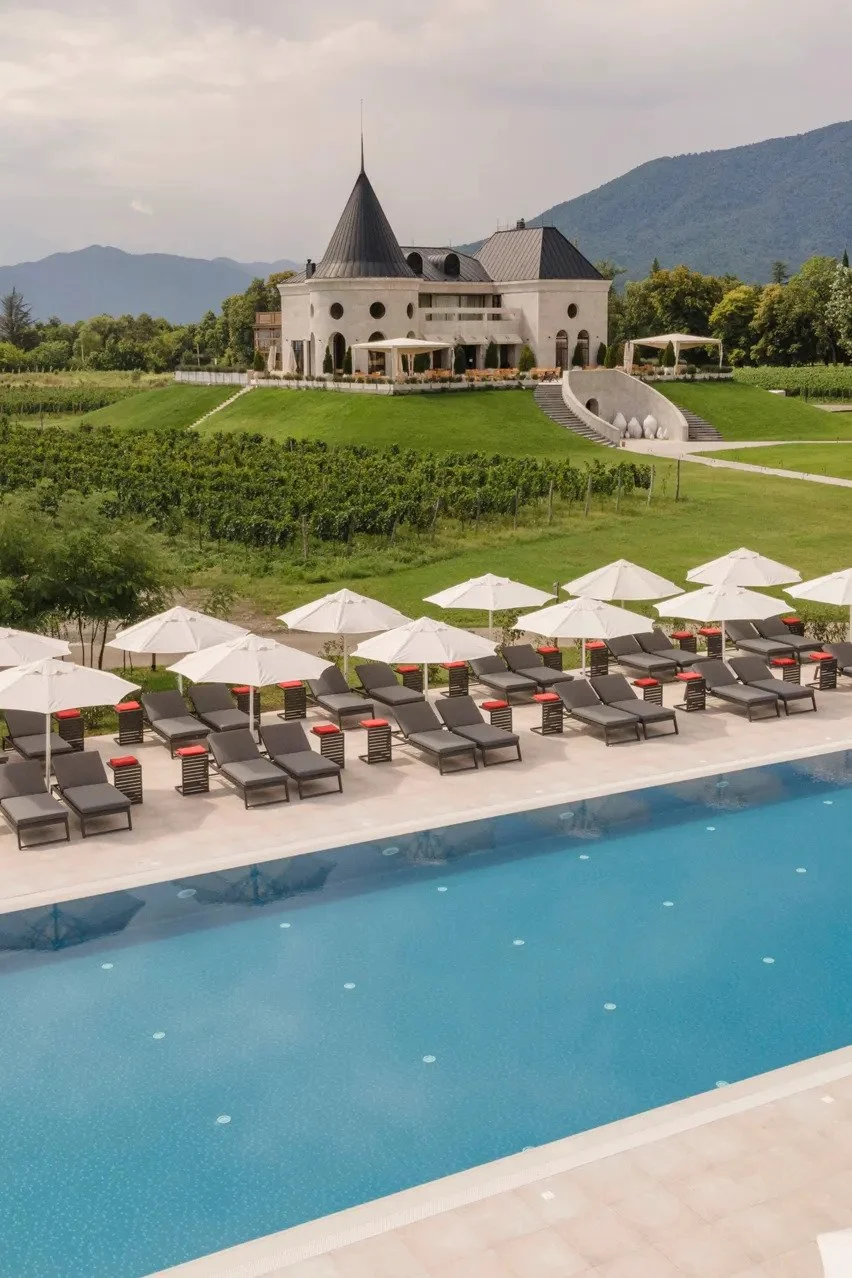British Vogue: The Obscure Wine Region That’s Becoming Georgia’s Answer To Bordeaux
Kakheti is one of Georgia’s most significant wine-making regions – and a wonderful introduction to everything the country has to offer, as Kin Woo discovers
If there’s one word I learnt quickly upon arriving in Georgia for the first time, it’s gaumarjos, or “cheers”. I got to say it multiple times over the course of my five days in the country – testament to the fact that feasting and toasting are essential components of Georgian culture. Once a stop on the Silk Road trade route, Georgia borders Russia, Turkey, Armenia and Azerbaijan, with the snow-capped Caucasus Mountains to the North and the Black Sea to the West: leading to a distinctive collision of ancient and new, Eastern and Western cultures. And while the capital, Tbilisi, remains a draw thanks to its plethora of museums, hot springs, buzzy design hotels, high-end dining and underground techno clubs; I wanted to experience Georgia’s wine-making traditions up close, and so I headed to Kakheti, the “cradle of wine” which is responsible for 70 per cent of the country’s production.
A two-hour drive from the capital, Kakheti is a mountainous landscape studded with ancient churches, verdant vineyards and lush green valleys. An ideal base from which to explore the region is Lopota Lake Resort, a sprawling 60-hectare family-owned resort centred around a serene lake and encompassing 311 guest rooms, six swimming pools, four restaurants, stables, and a spa and wellness centre hidden beneath a canopy of trees. Founded by Georgian businessman Goga Maisuradze as a seven-room hotel in 2008; the resort has gradually expanded over the years, adding a winery and vineyard, Château Buera, in 2018. When Maisuradze died in 2021, his daughter, Ana, took over running the resort and added some artful touches, opening a jazz club on the grounds with a rotating roster of local jazz talent, and playing host to an annual ceramics symposium every May. For guests looking for something more intimate, there’s the foliage-covered Tsinandali Estate, set on the historic Chavchavadze Estate, or Lost Ridge Inn, a boutique inn, craft brewery and horse ranch in Sighnaghi.
Four essential activities for your Kakheti itinerary
Go on (at least one) wine-tasting tour
Kakheti is one of the oldest wine-producing territories in the world. Its ancient wine-making technique dates back over 8,000 years, and has been declared a UNESCO Intangible Cultural Heritage. At Château Buera, Lopota’s onsite winery, grapes are plucked by hand and crushed by foot before being poured – seeds, stems and all – into bulbous clay vessels dug into the ground, known as qvevri, to ferment, a process that results in full-bodied reds, hearty amber-coloured whites, and blush pink rosé wines.
Ana’s husband, Sandro Kurdadze, takes us to visit his family’s vineyard, Papari Valley, located in the rolling hills of neighbouring Akhasheni, where grape varieties of Rkatsiteli and Saperavi are farmed and then turned into wine via an intricate three-terraced qvevri system. Later, Sandro’s parents prepare a mtsvadi (Georgian barbecue) in in an old qvevri vessel, which they serve with their own wine and chacha, a Georgian version of grappa. I’m already planning a return visit to Lopota in September for Rtveli – the autumn harvest festival where guests get to take part in crushing the grapes by foot.
Savour (and try your hand at making) Georgian cuisine
Blending Middle Eastern and Eastern European influences, Georgian cuisine is a mouthwatering mix of grilled meats and vegetables, herbaceous stews, simply dressed salads of sliced cucumber and tomatoes, and of course, Georgia’s national dish, khachapuri: warm, soft flatbreads stuffed with molten cheese. At Kakhetian Corner, one of Lopota Lake’s two Georgian restaurants, I get a masterclass in making shoti (Georgian flatbread) – rolling out the dough into long strips that are baked in a large cylindrical clay oven – as well as the ubiquitous soupy minced meat dumplings known as khinkali, dolloping mince into palm-sized circles of dough and pleating the edges to create dumplings that are then boiled. For a more modern take on Georgian cuisine, try Doli in the town of Telavi for buffalo kebabs and a walnut vegetable spread, served here with red peppers known as phkali. Or Pheasant’s Tears in the town of Sighnaghi, where chef Gia Rokashvili serves dishes like sauteed chanterelles and khashlama: a lamb stew in a slurry of sour plums simmered in tarragon, cilantro and mint.
Visit a monastery
Georgia adopted Christianity in the 4th Century, making it one of the world’s oldest Christian nations. Located a 30-minute drive from Telavi and overlooking the Alazani valley is Alaverdi Monastery, founded in the 6th Century by an Assyrian monk named Joseph Alaverdi. Unsurprisingly, it also boasts a tradition of wine-making that dates back to the 11th century, which the residents of the monastery continue to this day.
Discover traditional Georgian craft in the home of an artisan
Georgia has a rich textile tradition – memorably showcased in a 1989 photoshoot that Rei Kawakubo staged with photographer Brian Griffin for Comme des Garçons’ Six magazine, which saw her mix her own designs with traditional Georgian outfits. One artisan dedicated to revitalising and preserving the handicraft of the region is 85-year-old Lili Murtazashvili, a former schoolteacher from the village of Tusheti who started a traditional crafts business in 2005, which she runs out of her century-old family home in Kvemo Alvani. There, visitors can check out her traditional techniques of wool processing, carding, yarn spinning and dyeing, or purchase felted Tushetian rugs or colourful patterned socks and slippers.






